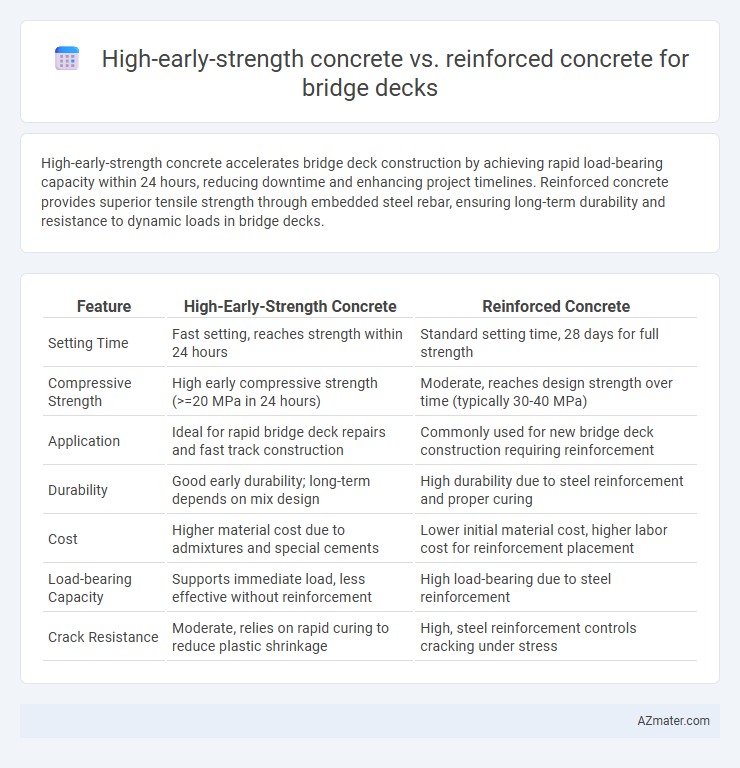High-early-strength concrete accelerates bridge deck construction by achieving rapid load-bearing capacity within 24 hours, reducing downtime and enhancing project timelines. Reinforced concrete provides superior tensile strength through embedded steel rebar, ensuring long-term durability and resistance to dynamic loads in bridge decks.
Table of Comparison
| Feature | High-Early-Strength Concrete | Reinforced Concrete |
|---|---|---|
| Setting Time | Fast setting, reaches strength within 24 hours | Standard setting time, 28 days for full strength |
| Compressive Strength | High early compressive strength (>=20 MPa in 24 hours) | Moderate, reaches design strength over time (typically 30-40 MPa) |
| Application | Ideal for rapid bridge deck repairs and fast track construction | Commonly used for new bridge deck construction requiring reinforcement |
| Durability | Good early durability; long-term depends on mix design | High durability due to steel reinforcement and proper curing |
| Cost | Higher material cost due to admixtures and special cements | Lower initial material cost, higher labor cost for reinforcement placement |
| Load-bearing Capacity | Supports immediate load, less effective without reinforcement | High load-bearing due to steel reinforcement |
| Crack Resistance | Moderate, relies on rapid curing to reduce plastic shrinkage | High, steel reinforcement controls cracking under stress |
Introduction to Bridge Deck Concrete Types
High-early-strength concrete (HESC) accelerates curing time, allowing bridge decks to reach design strength rapidly and reduce construction downtime. Reinforced concrete incorporates steel rebar to enhance tensile strength, making it suitable for handling dynamic loads and structural stresses in bridge decks. Selecting between HESC and reinforced concrete depends on project timelines, load requirements, and long-term durability considerations.
Overview of High-Early-Strength Concrete
High-early-strength concrete achieves compressive strength rapidly, typically reaching 70% of its 28-day strength within the first 24 hours, making it ideal for expedited bridge deck construction and reducing downtime. This concrete type incorporates special cementitious materials and admixtures that accelerate hydration, enhancing early load-bearing capacity and durability under heavy traffic conditions. Its high early strength allows for faster formwork removal and stress application, improving overall construction efficiency compared to traditional reinforced concrete.
Understanding Reinforced Concrete
Reinforced concrete for bridge decks combines concrete's compressive strength with steel reinforcement's tensile strength, providing enhanced durability and load-bearing capacity essential for heavy traffic and dynamic loads. The steel rebar embedded within the concrete improves crack resistance and prevents structural failure under tension, making it a preferred choice for long-span bridges. Understanding the synergy between concrete matrix and reinforcement is crucial for optimizing bridge deck design, ensuring safety, and extending service life.
Key Material Properties Comparison
High-early-strength concrete achieves rapid compressive strength gain, often reaching 7,000 psi within 24 hours, enabling faster construction cycles compared to traditional reinforced concrete that reaches similar strength over 28 days. Reinforced concrete incorporates steel reinforcement providing superior tensile strength and ductility critical for bridge deck load distribution and crack control under dynamic traffic loads. The combination of high-early-strength concrete's accelerated curing and reinforced concrete's structural resilience ensures optimized performance and durability in bridge deck applications.
Construction Speed and Project Timelines
High-early-strength concrete accelerates construction speed for bridge decks by achieving significant strength within 24 hours, enabling faster formwork removal and earlier load application compared to traditional reinforced concrete. Reinforced concrete requires longer curing times, typically 7 to 28 days, prolonging project timelines but offering proven durability and structural integrity. Utilizing high-early-strength concrete can shorten overall project durations, reducing labor costs and minimizing traffic disruptions on infrastructure projects.
Structural Performance and Load Capacity
High-early-strength concrete enhances structural performance in bridge decks by achieving rapid strength gain, allowing for earlier load application and reduced construction time compared to traditional reinforced concrete. Reinforced concrete offers superior load capacity through embedded steel reinforcement, providing enhanced tensile strength and durability under dynamic traffic loads. Combining high-early-strength concrete with reinforcement optimizes load-bearing capacity and structural resilience, making it ideal for accelerated bridge construction projects.
Durability and Longevity Considerations
High-early-strength concrete offers rapid strength gain, reducing construction time but may exhibit higher shrinkage leading to potential cracking under sustained loads. Reinforced concrete integrates steel rebar to enhance tensile strength and crack control, providing superior durability and extended service life in bridge decks subject to cyclic loading and environmental exposure. For longevity, reinforced concrete's balanced mechanical properties and corrosion-resistant treatments ensure enhanced resistance to freeze-thaw cycles, deicing salts, and fatigue, outperforming high-early-strength concrete in long-term structural resilience.
Cost Implications and Budget Analysis
High-early-strength concrete reduces construction time by achieving rapid curing, which lowers labor and equipment rental costs on bridge deck projects compared to traditional reinforced concrete. While reinforced concrete may have lower material costs, its longer curing period increases overall project duration and associated expenses, impacting the budget negatively. Careful budget analysis must weigh the upfront higher material cost of high-early-strength concrete against savings from accelerated construction schedules and reduced site overhead.
Maintenance Requirements and Lifespan
High-early-strength concrete accelerates bridge deck construction by achieving rapid cure times, which reduces initial maintenance needs and permits earlier load application, but it may experience higher shrinkage and cracking risks that require careful monitoring. Reinforced concrete provides enhanced structural integrity with embedded steel rebar, offering longer lifespan and greater resistance to tensile stresses, though it demands regular inspection and maintenance to prevent corrosion, spalling, and joint deterioration. Selection between high-early-strength and reinforced concrete for bridge decks depends on balancing rapid project timelines with long-term durability and maintenance strategies.
Best Practices for Bridge Deck Selection
High-early-strength concrete offers rapid strength gain, enabling faster construction schedules and early load application, making it ideal for accelerated bridge deck projects. Reinforced concrete provides enhanced tensile strength and durability through steel reinforcement, ensuring long-term structural integrity under cyclic traffic loads and environmental stress. Best practices recommend combining high-early-strength concrete with optimized reinforcement detailing to balance curing speed and durability for bridge decks exposed to heavy traffic and adverse weather conditions.

Infographic: High-early-strength concrete vs Reinforced concrete for Bridge deck
 azmater.com
azmater.com